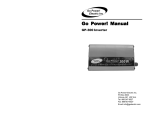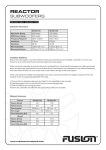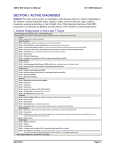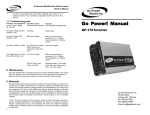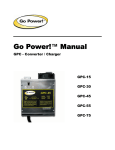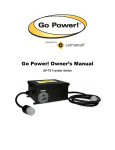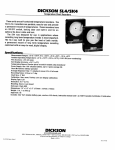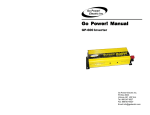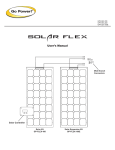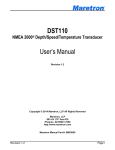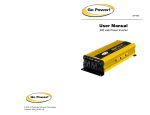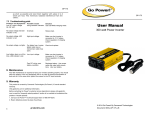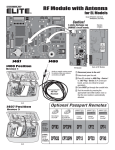Download Go Power! Manual
Transcript
Go Power! Manual GP-SW150 Inverter GP-SW300 Inverter Go Power! Electric Inc. PO Box 6033 Victoria, BC V8P 5L4 Tel: 866-247-6527 Fax: 866-607-6527 Email: [email protected] Go Power! SW150, SW300 Inverter Owner’s Manual Table of Contents 1. INTRODUCTION ........................................................................3 2. SPECIFICATIONS......................................................................3 3. NAME AND MAIN FUNCTION ...................................................4 4. INSTALLATION .........................................................................7 5. OPERATION ..............................................................................9 6. OPERATING LIMITS................................................................10 7. TROUBLESHOOTING .............................................................10 8. MAINTENANCE .......................................................................11 9. WARRANTY.............................................................................11 Go Power! Electric Inc. PO Box 6033 Victoria, BC V8P 5L4 Toll Free Tel: 866-247-6527 Toll Free Fax: 866-607-6527 Email: [email protected] GP Electric 05.05 Rev 2.3 GP-SW150_300 InstallGuide.doc 2 Go Power! SW150, SW300 Inverter Owner’s Manual 1. Introduction The Go Power! Sine Wave series models are used in a wide range of applications including remote homes, RVs, sailboats and powerboats. It will operate most televisions and VCRs, personal computers, small appliances and tools such as drills, sanders, grinders, mixers and blenders. The inverter must have a greater power rating than the load it is providing power to. To get the most out of the power inverter, it must be installed and used properly. Please read the instructions in this manual before installing and using this model. 2. Specifications 2.1 GP-SW150 W Inverter Model No. Continuous Output Power Surge Rating Output Waveform Output Voltage ± 3% Output Frequency ± 0.05% Input Voltage Efficiency No Load Current Draw / Powersave Protection Low Battery Alarm ± 2% Low Battery Shut-Down ± 2% Operating Temperature Range Storage Temperature Range Cooling AC Receptacle Dimensions (LxWxH) mm inches Weight kg / lbs Warranty Inverter Install Kit GP-SW150-12 GP-SW150-24 150 W 260 W Sine Wave <3% THD 115 VAC RMS 50 / 60 Hz adjustable 10.5-15 VDC 21.0-30.0 VDC 80-90% 0.20 A 0.15 A Overload, Short Circuit, Reverse Polarity (Fuse), Over / Under Voltage, Over Temperature 10.5 V 21.0 V 10.0 V 20.0 V 0 - 40°C / 32°F - 104°F -30°C - 70°C / -22°F - 158°F Thermostatically Controlled Fan Dual GFCI 200 x 132 x 72 8 x 5.3 x 2.9 2.7 / 5.9 2 Years Included 2.2 GP-SW300 W Inverter Model No. Continuous Output Power Surge Rating Output Waveform Output Voltage ± 3% Output Frequency ± 0.05% Input Voltage Efficiency No Load Current Draw / Powersave Protection Low Battery Alarm ± 2% Low Battery Shut-Down ± 2% Operating Temperature Range Storage Temperature Range Cooling AC Receptacle Dimensions (LxWxH) mm inches Weight kg / lbs Warranty Inverter Install Kit GP300-12 GP300-24 300 W 450 W Sine Wave <3% THD 115 VAC RMS 50 / 60 Hz adjustable 10.5-15 VDC 21.0-30.0 VDC 80 - 90% 0.26 A 0.23 A Overload, Short Circuit, Reverse Polarity (Fuse), Over/Under Voltage, Over Temperature 10.5 V 21.0 V 10.0 V 20.0 V 0 - 40°C / 32°F - 104°F -30°C - 70°C / -22°F - 158°F Thermostatically Controlled Fan Dual GFCI 237 x 155 x 72 9.3 x 6.1 x 2.8 3.5 / 7.7 2 Years Included 3 Go Power! SW150, SW300 Inverter Owner’s Manual 3. Name and main function 3.1 Front view GP-SW150: a. AC outlet c. Remote port b. ON /OFF switch d. Power status LED a) AC outlet: Outlet sockets available: North America b) ON / OFF switch: Power ON/OFF switch, leave in the OFF position during installation. c) Remote port d) Power status 4 Go Power! SW150, SW300 Inverter Owner’s Manual 3.2 Front view GP-SW300: a. ON /OFF switch c. AC outlet c. Remote port d. Power status LED a) ON / OFF switch: Power ON/OFF switch, leave in the OFF position during installation. b) AC outlet: Outlet sockets available: North America c) Remote port. d) Power status LED. 5 Go Power! SW150, SW300 Inverter Owner’s Manual 3.3 Rear view GP-SW150: a. Ventilation port b. DC Input Cables d. Chassis ground lug Warning! Operation of the inverter without a proper ground connection may result in an electrical safety hazard. a) Ventilation ports: Do not obstruct, allow at least 1 inch for air flow. b) DC Input Cables: Connect to battery or other power source: black is negative (-), red is positive (+). A reverse polarity connection will blow the internal fuse and may damage inverter permanently. c) Chassis ground or to vehicle chassis using # 8 AWG wire. 6 Go Power! SW150, SW300 Inverter Owner’s Manual 3.4 Rear view GP-SW300: b. Ventilation ports a. Chassis ground c. Battery terminal a) Chassis ground or to vehicle chassis using # 8 AWG wire. Warning! Operation of the inverter without a proper ground connection may result in an electrical safety hazard. b) Ventilation ports: Do not obstruct, allow at least 1 inch for air flow. c) Battery terminals: Connect to 12 V battery or other 12 V power source: [+] is positive and [-] is negative. A reverse polarity connection will blow the internal fuse and may damage inverter permanently. 4. Installation 4.1 Where to install The power inverter should be installed in a location that meets the following requirements: Caution Do not connect this inverter and another AC source (generator or utility power) to the AC wiring or AC loads at the same time. Doing so will destroy the inverter and void the warranty, regardless whether the inverter is switched on or off. If you are using more than one AC source for the AC wiring or AC loads, it is highly recommended that you install an automatic transfer switch (GP-TS), available from Go-Power Electric Inc. a) Dry - Do not allow water to drip or splash on the inverter. b) Cool - Ambient air temperature should be between 0°C and 40°C (the cooler the better). c) Ventilated - Allow at least two inches of clearance around the inverter for air flow. Ensure the ventilation openings on the rear and bottom of the unit are not obstructed. d) Safe - Do not install the inverter in the same compartment as batteries or in any compartment capable of igniting flammable liquids such as gasoline. e) Inverter should be located within 10 feet of the batteries. 7 Go Power! SW150, SW300 Inverter Owner’s Manual 4.2 Hook-up and testing Caution! A reverse polarity connection will blow a fuse in the inverter and may permanently damage the inverter. Damage caused by reverse polarity connection is not covered by our warranty. 1. Unpack and inspect your Go Power! Inverter, check to see that the power switch is in the OFF position. 2. Connect the negative cable (black) to the negative terminal of the battery. Make a secure connection. Caution! Loose connections result in excessive voltage drop and may cause overheated wires and melted insulation. 3. Before proceeding further, carefully check that the cable you have just connected, connects from the negative terminal of inverter to the negative output terminal of the power source. 4. Install the recommended inverter fuse in positive lead. Fuse should be located within 12” of battery. Ensure all connections are tight and secure. (See 4.3) 5. Connect the positive cable (red) to the positive terminal of the battery. Make a secure connection. Warning! You may observe a spark when you make the positive connection since current may flow to charge capacitors in the power inverter. Do not make this connection in the presence of flammable fumes, as explosion or fire may result. 6. Set the power switch to the ON position. Check indicator on the front panel of the inverter to ensure that it is red. 7. Set the power inverter switch to the OFF position. The indicator light may blink and the internal alarm may sound momentarily. This is normal. Plug the test load into the AC receptacle on the front panel of the inverter. 8. Set the power inverter switch to the ON position and turn the test load on; the inverter should supply power to the load. If you plan to measure the output voltage of the inverter, a true r.m.s. meter must be used for accurate readings. 4.3 Cables Please use a 35 Amp fuse (not included) with the supplied #10 Cable. Install the inverter fuse into the positive lead. Fuse should be located within 12” of battery. Ensure all connections are tight and secure. 4.4 Grounding Warning! Do not operate the power inverter without connecting it to ground. Electrical shock hazard may result. The power inverter has a lug on the rear panel: “Chassis Ground.” This is to connect the chassis of the power inverter to the ground. The ground terminals in the AC outlets on the front of the inverter are also connected to the ground lug. If available, the chassis ground lug should be connected to a ground point, which will vary depending on where the power inverter is installed. In a vehicle, connect the chassis ground to the chassis of the vehicle. In a boat, connect to the boat’s grounding systems. In a fixed location, connect the chassis ground lug to earth. The neutral (common) conductor of the power inverter AC output circuit is not bonded to the chassis ground. Therefore, when the chassis is connected to ground, the neutral conductor will not be grounded. At no point should the chassis ground and the neutral conductor of the inverter be bonded. Bonding the chassis ground and the neutral conductor of the inverter or connecting the inverter to household or recreational AC distribution wiring will damage the unit and void the warranty. 8 Go Power! SW150, SW300 Inverter Owner’s Manual Caution! The negative DC input of the power inverter is connected to the chassis. Do not install the power inverter in a positive ground DC system. A positive ground DC system has the positive terminal of the battery connected to the chassis of the vehicle or to the grounding point. 5. Operation To operate the power inverter, turn it on using the ON/OFF switch on the front panel. The power inverter is now ready to deliver AC power to your loads. If you are operating several loads from the power inverter, turn them on separately after the inverter has been turned on. This will ensure that the power inverter does not have to deliver the starting-currents for all the loads at once. 5.1 Operating On/Off Switch The ON/OFF switch turns the control circuit in the power inverter ON and OFF. It does not disconnect power from the power inverter. When the switch is in the OFF position, the power inverter draws no current from the battery. When the switch is in the ON position but with no load, the power inverter draws approximately 0.20 A from the battery. 5.2 Power Status The power status LED indicates the operating state of the inverter. If the LED is green, then the inverter is in operational mode and producing approximately 115 V AC. If the LED is red or flashing red, then the inverter is in fault mode and there is no AC output. Some common faults include: 5.2.1 Over voltage indicator (Red LED Blinking Fast) The over voltage indicator indicates that the power inverter has shut itself down because its input voltage has been over 16.5 VDC for the 12 V and 32.0 VDC for the 24 V. 5.2.2 Under voltage indicator (Red LED Blinking Slowly) The under voltage indicator indicates that the power inverter has shut itself down because its input voltage has been lower than 10.0 VDC for the 12 V and 20.0 VDC for the 24 V. 5.2.3 Over temp indicator: (Red LED Blinking Intermittently) The over temp indicator indicates that the power inverter has shut itself down because it has become overheated. The power inverter may overheat because it has been operated at power levels above its rating, or because it has been installed in a location which does not allow it to dissipate heat properly. The power inverter will restart automatically once it has cooled off. 5.2.4 Overload indicator: (Red LED Solid) The overload indicator indicates that the power inverter has shut itself down because its output circuit has been short circuited or drastically overloaded. Switch the ON/OFF switch to OFF, correct the fault condition, and then switch the ON/OFF switch back to ON. 5.3 Resetting Faults Any of the inverters protection faults can be re-set by turning the inverter off for five seconds and then turning the inverter on again. The GP-SW150 can also re-set any of its protection faults using the optional remote on/off switch to turn the inverter off and then on again. 9 Go Power! SW150, SW300 Inverter Owner’s Manual 5.4 Remote A user supplied remote option is available. When the on/off button is put to the remote setting, the inverter will only work if a connection is made between the two terminals of the remote input. A small screwdriver may be used to tighten the two terminals. A switch may be placed between the two terminals and the inverter will now be turned off via the switch. It is recommended that #18 gauge wire no more that 150 feet (terminal to terminal) be used for this application. 6. Operating limits 6.1 Power output: Some induction motors used in refrigerators, freezers, pumps, and other motor-operated equipment require very high surge currents to start. The power inverter may not be able to start some of these motors even though their rated current draw is within the power rating of inverter. Televisions and computer monitors may surge up to four times their rated power on startup, which may result in the inverter showing an overload fault. 6.2 Input voltage: The power inverter will operate from input voltage ranging 10 V – 15 V (12 V) / 20 V – 30 V (24 V). The power inverter will shut down if the input voltage drops below 10 / 20 V. This protects your battery from being over discharged. The power inverter will also shut down if the input voltage exceeds 16 / 32 V. This protects the inverter against excessive input voltage. Although the power inverter incorporates protection against over voltage, it may still be damaged if the input voltage is allowed to exceed 20 / 40 V. 7. Troubleshooting 7.1 Common problems Television interference: Operation of the power inverter can interfere with television reception on some channels. If this situation occurs, the following steps may help to alleviate the problem. • Make sure that the chassis ground lug on the back of the power inverter is solidly connected to the ground system of your vehicle, boat or home. • Do not operate high power loads with the power inverter while watching television. • Make sure that the antenna feeding your television provides an adequate ("snow free") signal and that you are using good quality cable between the antenna and the TV. • Move the television as far away from the power inverter as possible. • Keep the cables between the battery and the power inverter as short as possible and twist them together with about 2 to 3 twists per foot. This minimizes radiated interference from the cables. 10 Go Power! SW150, SW300 Inverter Owner’s Manual 7.2 Troubleshooting guide Problem and Symptoms No output voltage, red LED blinking fast Possible Cause High input voltage No output voltage, red LED blinking slowly No output voltage, load in excess of: 150 W. Red LED blinking intermittently No output voltage, load less than: 150 W. Red LED blinking intermittently No output voltage, red LED solid Poor DC wiring, poor battery condition. Thermal shutdown No output voltage, red LED blinking slowly No output voltage, previous solutions are not working Thermal shutdown Overload Low input voltage Inverter switched off. No power to inverter Car lighter fuse open Internal fuse open Reverse DC polarity No output voltage, Over Load indicator ON. Short circuit or wiring error. Solution Make sure that inverter is connected to 12 V battery. Check regulation of charging system. Use proper cable and make solid connections. Use new battery. Allow inverter to cool off. Reduce load if continuous operation required. Improve ventilation, make sure ventilation openings in inverter are not obstructed, reduce ambient temperature. Reduce load Recharge battery, check connections and cable. Turn inverter ON. Check wiring to inverter. Replace Have qualified service technician check and replace. Have qualified service technician check and replace fuse, OBSERVE CORRECT POLARITY. Check AC wiring for short circuit or improper polarity (hot and neutral reversed). 8. Maintenance Very little maintenance is required to keep your inverter operating properly. You should clean the exterior of the unit periodically with a damp cloth to prevent accumulation of dust and dirt. At the same time, tighten the screws on the DC input terminals. 9. Warranty We warrant this product against defects in materials and workmanship for a period of two years from the date of purchase and will repair or replace any defective Go Power! Inverter when directly returned, postage prepaid, to manufacturer. This warranty will be considered void if the unit has suffered any obvious physical damage or alteration either internally or externally and does not cover damage arising from improper use such as plugging the unit into an unsuitable power sources, attempting to operate products with excessive power consumption requirements, reverse polarity, or use in unsuitable climates. This is the only warranty and the company makes no other warranties, express or implied, including warranties of merchantability and fitness for a particular purpose. Repair or replacement are your sole remedies and shall not be liable for damages, whether direct, incidental, special or consequential, even though cause by negligence or other fault. 11











